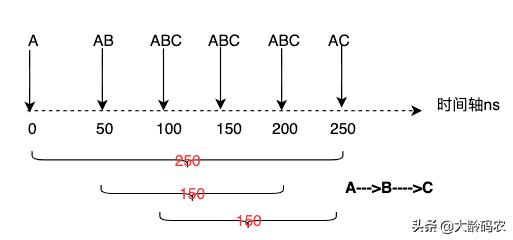引言:好久没分享了,不多废话了,准备一个专题分三期来分享下golang的性能分析。
O 专题目标
- 理解profile基本原理
- 熟悉go常用性能分析工具pprof
- 快速对线上服务的cpu、内存、goroutine的问题进行分析和排查
对性能分析,golang是采取采样分析的方式,语言原生支持对运行的程序进行采样,收集采样数据通过累加计算并通过提供相应的工具来分析堆栈信息。【对比java:java通过发布jdk周边工具jps jmap jstack等,在问题分析前先将内存中的数据进行dump的方式进行分析】
一 profile原理
A Profile is a collection of stack traces showing the call sequences that led to instances of a particular event, such as allocation. Packages can create and maintain their own profiles; the most common use is for tracking resources that must be explicitly closed, such as files or network connections.
go默认会初始化六种profile, 每种profile存储的实际内容被抽象为 countProfile,存储栈帧地址,堆栈地址通过调用runtime.CallersFrames(stk)可以获取堆栈信息,下面主要讲最常用的三种方式:内存、CPU和协程
type countProfile interface { Len() int Stack(i int) []uintptr}// A countProfile is a set of stack traces to be printed as counts grouped by stack trace. There are multiple implementations:all that matters is that we can find out how many traces there are and obtain each trace in turn.- 内存采样
go程序启动后,runtime会按照一定频率对内存的分配进行采样记录,当内存分配每达到一定值(默认是512KB,参数由runtime.MemProfileRate设定), runtime就会记录下当前这次内存分配的大小、stack等信息到profile
type MemProfileRecord struct { AllocBytes, FreeBytes int64 // number of bytes allocated, freed AllocObjects, FreeObjects int64 // number of objects allocated, freed Stack0 [32]uintptr // stack trace for this record; ends at first 0 entry}- CPU采样
cpu的采样是通过调用函数StartCPUProfile来启动采样的,结束调用StopCPUProfile调用链如下StartCPUProfile->runtime.SetCPUProfileRate->sighandler;采样频率是100hz
// The runtime routines allow a variable profiling rate,// but in practice operating systems cannot trigger signals// at more than about 500 Hz, and our processing of the// signal is not cheap (mostly getting the stack trace).// 100 Hz is a reasonable choice: it is frequent enough to// produce useful data, rare enough not to bog down the// system, and a nice round number to make it easy to// convert sample counts to seconds. Instead of requiring// each client to specify the frequency, we hard code it.const hz = 100// readProfile, provided by the runtime, returns the next chunk of// binary CPU profiling stack trace data, blocking until data is available.// If profiling is turned off and all the profile data accumulated while it was// on has been returned, readProfile returns eof=true.// The caller must save the returned data and tags before calling readProfile again.func readProfile() (data []uint64, tags []unsafe.Pointer, eof bool)- goroutine采样
GMP模型中,G goroutine P context M thread,采样数据来源于P,运行中的协程上下文堆栈。P会维护当前执行队列,队列中是M对应的G队列。自行检索GPM原理(关键字:窃取、61分之一全局队列)
如何将采样内容汇总?
假设我们在程序执行的某个时刻取样得到一个栈帧序列是ABC,可以得到的信息包括:此刻运行的函数是C,是从函数B调用到C的。当取样很多次后进行统计,就可以得到调用的信息。比如对下面这段代码的取样:
- void A() { B(); for (int i=0; i<3; i++) C(); } void B() { for (int i=0; i<5; i++) C(); }
- 将得到
- A AB ABC ABC ABC AC 根据统计信息: 函数累加耗时和调用关系,根据这些数据可以构造有向图

profiles采样后会以pprof-formatted格式存储起来,分析这些数据需要用到golang的分析工具。
下一节分享golang常用的分析工具,敬请期待。欢迎关注"大龄码农


)




安装jdk)



安装MySQL)



——SS加强级高塔)



